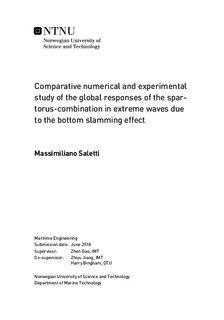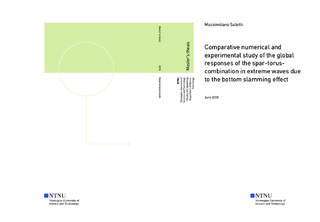| dc.description.abstract | The purpose of this graduation thesis "Comparative numerical and experimental study of the global responses of the spar-torus-combination in extreme waves due to the bottom slamming effect" is to investigate the effects of nonlinear loads caused by slamming on the spar torus combination (STC) concept.\newline
The STC concept is a device that integrate wind and wave energy and is composed of a 5 MW spar-type floating wind turbine and an axisymmetric wave energy converter (torus) that heaves along the spar to extract energy from waves through a hydraulic power take-off system (PTO). Among renewable energy resources, both offshore wind and wave energy have a great potential. However, the development of wind energy technology has already been commercialized while wave energy technology is still immature. In order to bring offshore renewable energy applications closer to the market, structures like the STC have been proposed under the European Commission FP7 Marine Renewable Integrated Application Platform (MARINA PLATFORM) project. Several benefits might be identified from the integration of wind and wave energy devices in one single structure, such as the reduced investment cost derived from the use of the same infrastructure, the positive synergy in terms of dynamic responses of the structure and augmentation of the produced power.\newline
Experimental data for this thesis were collected at Sintef Ocean for different survival modes proposed for the STC to ensure the structural integrity under extreme environmental conditions due to large wave forces on the torus. Tests performed in the Mean Water Level (MWL) survival mode, where the torus is fixed to the spar at mean water level, highlighted water exit and entry phenomena due to excessive heave motions of the floater, which leads to significant wave slamming loads on the bottom of the torus.
Nonlinear hydrodynamic properties have been studied in order to compare the experimental results with the time-domain code SIMO \cite{simo}, which is based on the linear potential theory. A simplified nonlinear wave load model in SIMO (which is basically a correction of the linear model considering the nonlinear buoyancy force, the nonlinear Froude-Krylov force, and the slamming force) have been developed and implemented, with focus on the interface forces between the torus and the spar.
Slamming phenomena have been investigated applying the strip-theory approach in the local x-direction. For each strip, the local Wagner-type solution is considered. Moreover, nonlinear Buoyancy and Froude-Krylov force have been studied using both pressure integration and Sclavounos methods and implemented in SIMO.
On the basis of the results of this research, it can be concluded that it is possible to reach good agreement between experimental and numerical results implementing in SIMO the nonlinear loads.
The author recommends further modification on the model in SIMO in order to be able to implement Wagner's slamming solution. Furthermore a structural assessment on the structure should be carried out considering the slamming force and the vibrations that it generates. | |

